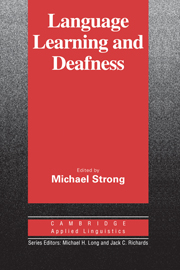Book contents
- Frontmatter
- Contents
- List of contributors
- Series editors' preface
- Preface
- SECTION I THEORETICAL ISSUES
- SECTION II RESEARCH REPORTS
- Chapter 6 An assessment of syntactic capabilities
- Chapter 7 Children's new sign creations
- Chapter 8 Linguistic and cultural role models for hearing-impaired children in elementary school programs
- Chapter 9 Acquiring linguistic and social identity: interactions of deaf children with a hearing teacher and a deaf adult
- Chapter 10 Development of vocal and signed communication in deaf and hearing twins of deaf parents
- Chapter 11 Questions and answers in the development of deaf children
- Index
Chapter 9 - Acquiring linguistic and social identity: interactions of deaf children with a hearing teacher and a deaf adult
Published online by Cambridge University Press: 05 October 2012
- Frontmatter
- Contents
- List of contributors
- Series editors' preface
- Preface
- SECTION I THEORETICAL ISSUES
- SECTION II RESEARCH REPORTS
- Chapter 6 An assessment of syntactic capabilities
- Chapter 7 Children's new sign creations
- Chapter 8 Linguistic and cultural role models for hearing-impaired children in elementary school programs
- Chapter 9 Acquiring linguistic and social identity: interactions of deaf children with a hearing teacher and a deaf adult
- Chapter 10 Development of vocal and signed communication in deaf and hearing twins of deaf parents
- Chapter 11 Questions and answers in the development of deaf children
- Index
Summary
Editor's introduction
The topic of role models, raised in Chapter 8, is explored in depth by Erting, She reports here on an ethnographic study of three deaf preschool children interacting with their hearing teacher and a visiting deaf adult. From her examination of the videotaped interactions and from interviews, Erting was able to distinguish clear differences in orientation between the deaf and hearing adults. In spite of her training and experience working with deaf children, the hearing teacher consistently adopted hearing strategies in her interactions that often led to misunderstandings and miscommunication. This apparent refusal by the teacher to accept fully that the children were deaf, and a tendency to treat them as trainees for a hearing society rather than as deaf children, distinguished her from the deaf adult whose orientation was appropriately visual and Deaf. This detailed observation and analysis of a single situation complements nicely the survey data presented by Woodward, Allen, and Schildroth in Chapter 8 and adds strength to their concerns about the ramifications of their findings. If Erting s findings are typical – and there is no reason to suspect that they are not – her recommendation that more deaf teachers be hired would help to ameliorate the problem, as would the better training of educators of the deaf in cultural, linguistic, and cognitive aspects of deafness. Erting s preference for a team teaching approach with one deaf and one hearing teacher is a particularly good one and lends itself readily to the kind of bilingual approach advocated by Strong in Chapter 5.
- Type
- Chapter
- Information
- Language Learning and Deafness , pp. 192 - 219Publisher: Cambridge University PressPrint publication year: 1988
- 4
- Cited by

